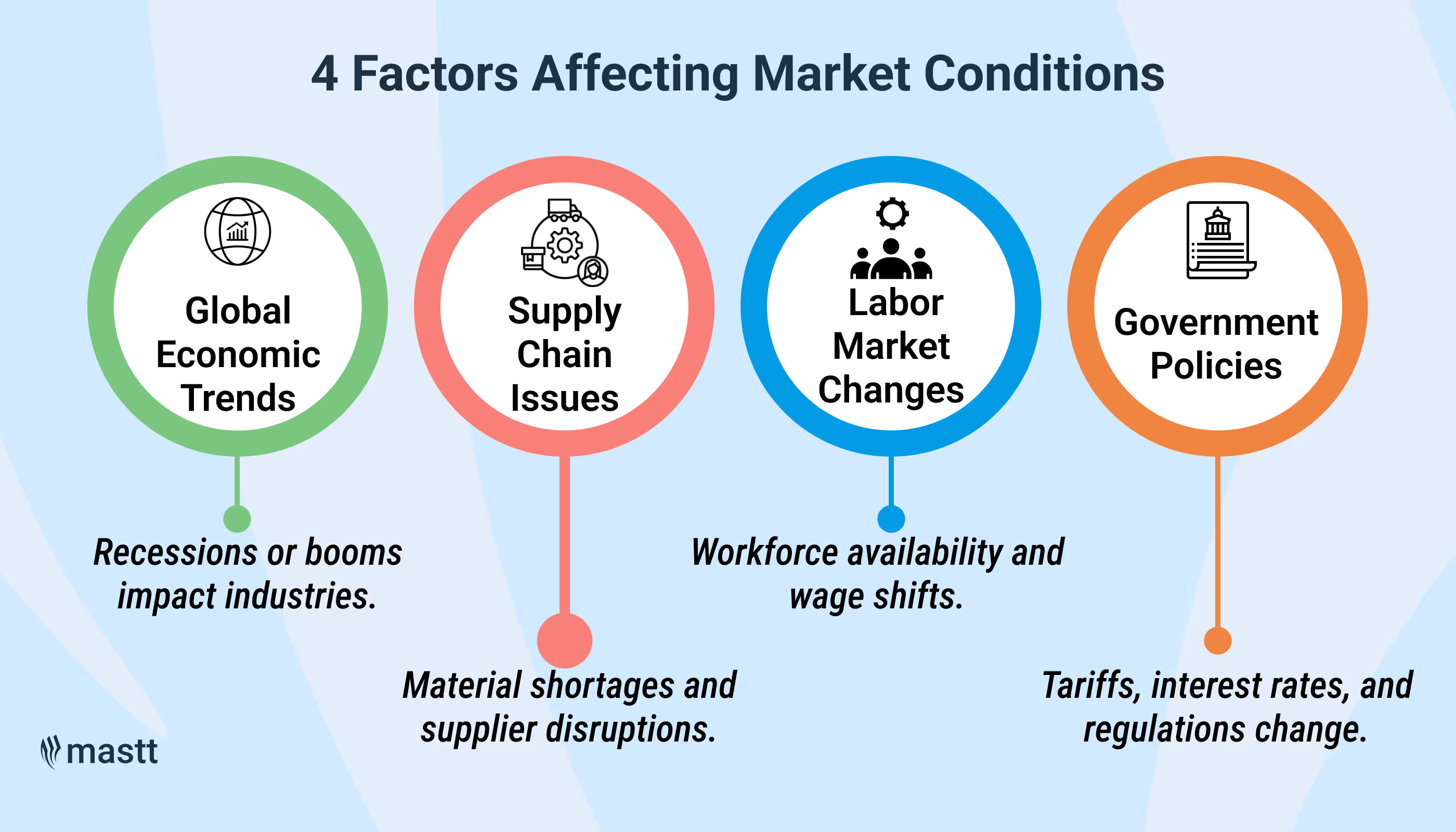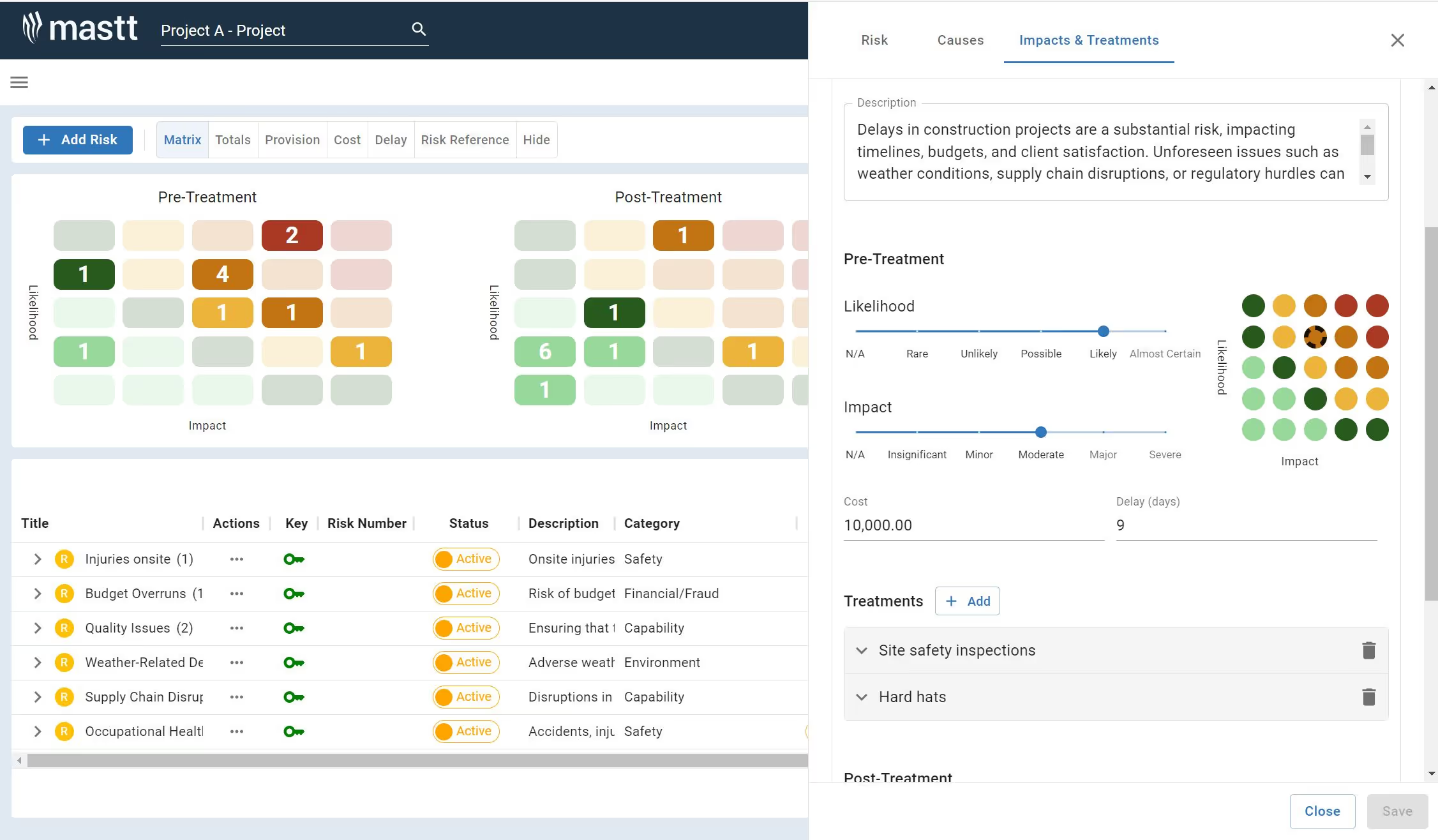What is Market Conditions?
Market Conditions refers to economic and financial factors that affect the construction industry. These can include fluctuations in the cost of materials, labor availability, interest rates, and the overall economic climate. Instability in these conditions can significantly impact project costs, timelines, and feasibility where supply chain and labor are necessary ingredients for a successful project.
What does Market Conditions mean?
'Market Conditions' mean the external economic environment that can any aspect of a Capital Project. Market Conditions influence Project Owner decision-making, General Contractor's project planning, and everyone's financial outcomes. Changes in market conditions can lead to increased costs, project delays, or even the need to reassess project viability.
Market Conditions Example
An example of market conditions affecting construction is a sudden increase in steel prices due to international trade policies. This increase can significantly raise costs for projects relying heavily on steel, such as high-rise buildings. Project Owners often engage General Contractors on fixed price contracts, a risk owned by the General Contractor but ultimately affects the Project Owner (should the General Contractor go bust). Due to the increase in costs, it is common to see construction contracts affected potentially leading to budget overruns or project delays.
Deloitte provide an annual market conditions report, and titled 'engineering and construction industry outlook'.
The History of Market Conditions
The construction industry has always been sensitive to economic cycles. During periods of economic growth, construction demand increases, leading to higher costs for materials and labor. Conversely, in economic downturns, lower demand can decrease costs but also reduce the number of available projects, affecting the industry's overall profitability.
Causes of Market Conditions
Market conditions in construction can be influenced by several factors:
- Global economic trends: Changes in the global economy, including recessions or booms.
- Supply chain issues: Fluctuations in the availability of materials or changes in supplier dynamics.
- Labor market changes: Variations in labor availability and wage levels due to economic conditions or policy changes.
- Government policies: Trade tariffs, interest rate changes, and regulatory modifications.

Likelihood of Market Conditions
The likelihood of market condition fluctuations is always present but varies in intensity based on economic cycles and external global events. Project Owners and General Contractors need to pay attention to these conditions and adapt their capital improvement strategies accordingly.
Consequence / Impact of Market Conditions
The impact of adverse market conditions can be severe. These impacts include significant increases in project costs, reduced profit margins, project delays, or complete project cancellations is financial viability erodes. Conversely, favorable market conditions can lead to increased profitability and business growth opportunities.
Market Conditions Clauses in Construction Contracts
Market Conditions clauses in construction contracts are not typically standard but would be wise to include to mitigate financial risk:
- Price Adjustment Clauses: Clauses that allow for contract price adjustments in response to significant changes in material or labor costs.
- Force Majeure Clauses: Including economic downturns or disruptions as a force majeure event.
- Escalation Clauses: Permit adjustments to the contract price based on predefined indices related to economic factors.
Mitigations and Treatments for Market Condition Risks
In addition to the clauses above, effective mitigation and treatment strategies for market conditions risk include:
- Financial Hedging: Using financial instruments to hedge against significant price fluctuations in materials or currencies.
- Fixed Pricing: Attempt to lock prices in early on long lead time items or bulk materials avoid floating price risk.
- Flexible Sourcing Strategies: Establishing relationships with multiple suppliers to mitigate the risk of supply chain disruptions.
- Dynamic Project Planning: Incorporating flexibility in project planning to adapt to changing economic conditions.
- Continuous Market Analysis: Regularly analyzing market conditions and adjusting construction project management and financial planning strategies accordingly.
Risk Management and Reporting of Market Condition Risks
As we've seen above, there are lots of considerations when it comes to Risk Management. Implementing Risk Management and Construction Reporting controls will make managing this risk easy, and ensure success of your Capital Project.
- Risk Management Plan: Download a free Risk Management Plan Template and put a Risk Management process in place.
- Risk Register: Download a manual Risk Register Template or use an automated Risk Register solution to track all risks, causes, consequences and mitigations.
- Reporting: Create automated Risk Reports, Project Status Reports or Dashboards for communicating with stakeholders. If you need a free Report Template, you can find more in our templates library.

Why take the 'Risk'? 😂 Start today with Mastt's fast, easy Risk Management solution
Replace spreadsheet risk registers instantly and unlock opportunities to complete Capital Projects earlier with reduced costs using Mastt.























